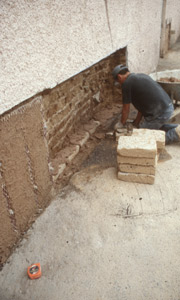Caging Adobes and Capturing the Zia
Ed Crocker
A few years ago we were called upon to stabilize a two-story adobe building north of Taos. It was January, there was snow on the ground, and the structure we were to treat was sitting in a low spot that held runoff from bar-ditches at an intersection. Not pretty. The contractor had peeled off some of the cement plaster and discovered, to his horror, that the walls at the base were mere pedestals, having lost nearly half their thickness over time. Fortunately, even though they were only single wythe walls fourteen-inches thick, they were frozen solid as a rock and thus still capable of bearing the loads if everyone remained light-footed and refrained from using space heaters.
It was grim, but naturally we said we had seen worse and could, of course, fix it.
I won't describe in detail how we first wrapped the building in polypropylene strapping and guyed it to anchors, or how on warm days when the south wall began to thaw, we got religion. What I will describe is a technology that my son, Jess, invented in a moment of fear-incited creativity as he faced a newly stripped section of wall with holes clean through at the base and 18 feet of wavering adobe towering above.
 His fear was to remove, or even touch, the adobes and upset the delicate balance. So he built what came to be known as "adobe cages." Essentially, he welded 1-inch channel-iron into frames with sufficient bracing to make them rigid, then welded a heavy gauge expanded metal over the frames. The dimensions of the frames fit sections of the wall and were intended to encase the bottom three feet. By mixing a lime-rich mud and piling it into the damaged wall, then filling the low-profile cage with the same material, he could then through-bolt two cages together, one within and the other outside, with minimal interference to the original wall. The resulting sandwich served the purpose brilliantly: It was structural (after the moment of crisis passed we had them engineered), reversible if necessary, completely vapor permeable because of the expanded metal, and of such low profile that we could later plaster directly over them.
His fear was to remove, or even touch, the adobes and upset the delicate balance. So he built what came to be known as "adobe cages." Essentially, he welded 1-inch channel-iron into frames with sufficient bracing to make them rigid, then welded a heavy gauge expanded metal over the frames. The dimensions of the frames fit sections of the wall and were intended to encase the bottom three feet. By mixing a lime-rich mud and piling it into the damaged wall, then filling the low-profile cage with the same material, he could then through-bolt two cages together, one within and the other outside, with minimal interference to the original wall. The resulting sandwich served the purpose brilliantly: It was structural (after the moment of crisis passed we had them engineered), reversible if necessary, completely vapor permeable because of the expanded metal, and of such low profile that we could later plaster directly over them.
It was a stunning achievement, I thought, and a technology that we have used many times since, including at the Zia Diner on Guadalupe Street. There the challenge was to repair the slumping north wall while the clientele, blissfully unaware, sipped their martinis and nibbled their Cobb salads.
If you know the Zia, you know the booths along the north wall are on an elevated dais. With a crew on the outside and another subtly slithering around under the booths, we were able to capture the wall without the loss, or even the knowledge of a single diner. If you have a good eye for texture, you will note a very slight seam in the pebble-dash finish on the outside, about four feet above grade. That is the only visible evidence of the intervention which, on this National Register building, we wanted to keep to the barest minimum.
Several times a year now we use the adobe cage system, and we keep a stack of the hardware handy for emergencies. Jess cringes every time he looks at it.

